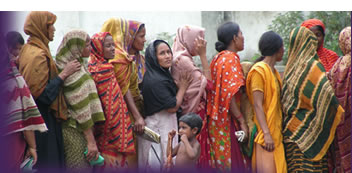Stage 1
Diagnosis (obtaining and analysing baseline information)
Step 1. Details of the study locations/village livelihood profile
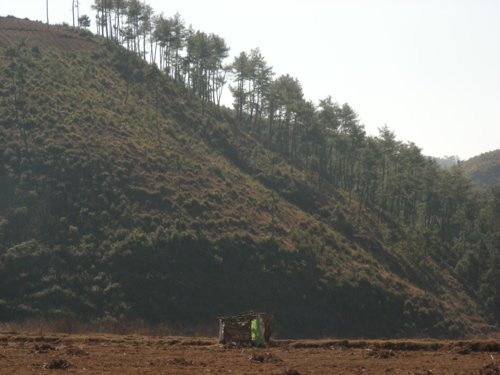 Gajpathi, is one of the poorest districts of Orissa, with 68% population living below the poverty line. The district headquarters is at Parlakhemundi. Gumma is a block with hilly terrain and undulated topography and is inhabited by the tribals (Souras) in most of the villages. Land is one of the major issues of Gajapati particularly in the Gumma block. Most of the area falls under the forest category as per the government records. The tribal people have no record of rights over the land although they are staying there for a long time. Tribals grow a number of horticultural crops (pineapple, oranges, jack fruit, mangos, cashew and lemon). However, they continue to remain poor, despite the fact that these crops have high demand in the cities and have high potential for value addition. Apart from Jhum cultivation, some plain lands are irrigated using small natural springs and/or canals. Mostly paddy is grown on these patches of land. Gajpathi, is one of the poorest districts of Orissa, with 68% population living below the poverty line. The district headquarters is at Parlakhemundi. Gumma is a block with hilly terrain and undulated topography and is inhabited by the tribals (Souras) in most of the villages. Land is one of the major issues of Gajapati particularly in the Gumma block. Most of the area falls under the forest category as per the government records. The tribal people have no record of rights over the land although they are staying there for a long time. Tribals grow a number of horticultural crops (pineapple, oranges, jack fruit, mangos, cashew and lemon). However, they continue to remain poor, despite the fact that these crops have high demand in the cities and have high potential for value addition. Apart from Jhum cultivation, some plain lands are irrigated using small natural springs and/or canals. Mostly paddy is grown on these patches of land.
Table 1. Land use pattern in Gumma block.
Details |
Area (ha) |
Percent to total |
Agriculture-irrigated |
481 |
8.00 |
Agriculture-rain fed |
1653 |
27.47 |
Common lands (grazing, forests etc) |
3860 |
64.15* |
Water Bodies |
23 |
0.38 |
Total Area |
6017 |
|
|
*Much of the horticulture in Gumma is in the designated forestland. Collection of NTFP is an important occupation in Gumma.
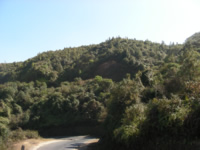 The land use pattern indicates the predominance to rain fed agriculture to a reasonable extent in Gumma. There is a lack of irrigation water and the average land holding size (0.79 ha) is small. Area under common lands is high in Gumma. This mostly includes forestlands where people cultivate a large number of horticultural crops and collect non-timber forest products. The land use pattern indicates the predominance to rain fed agriculture to a reasonable extent in Gumma. There is a lack of irrigation water and the average land holding size (0.79 ha) is small. Area under common lands is high in Gumma. This mostly includes forestlands where people cultivate a large number of horticultural crops and collect non-timber forest products.
Table 2. Main features of village livelihood in Gumma block.
| Livelihood sector |
Livelihood Pattern |
Agriculture |
Shifting cultivation-rain fed
Millets, cereals, pulses, turmeric
Small patches of plain land used for paddy cultivation |
Livestock |
Poultry (1-2 birds in most of the households)
Goats and cattle rearing limited |
Forestry |
Fuel-wood
Growing cashew, banana, pineapple, mango
Collection of tamarind and broomsticks |
Fisheries |
Negligible |
Labour |
High dependence in destitute and poor households |
Migration |
Chain migration to Arunachal Pradesh
High Migration to big cities in south India |
|
Many people depend on agriculture and a declining natural resource base. The dependence on unskilled labour is high. Migration is an important coping strategy. Though horticulture in forest and collection of NTFPS do provide diverse livelihood options, people sell most of the produce in distress and without any value addition. Poultry and goat rearing are important activities in Gumma.
Step 2. Details of household livelihood profiles
The tribal households have a particular livelihood pattern. They cultivate their traditional pulses and millets in the forest (to which they have informal rights) after burning a patch of land, clearing the rocks and sowing seeds (Jhum cultivation/shifting cultivation). The agriculture is mostly rain fed. They take crop in this land for three years and then move to another patch of land. However, this is carried out strictly in the forestland belonging to that village. During the last two decades, the tribals were growing cashew and it has greatly benefited them. Earlier, the tribals used to sell their products after collecting. With the influence of several NGOs, many of them have now started adding value (tamarind, turmeric, pineapple, jackfruit, etc) by drying, storing and processing e.g. jackfruit and pulses. Livestock includes bullocks, cows, goats and poultry (all at a very small scale and for sustenance in the sample villages).
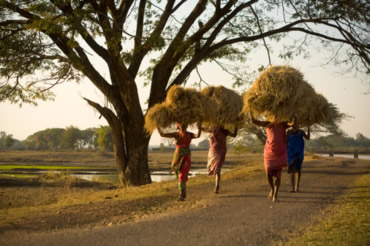 Surrounding the tribal villages, there are pockets of villages with OBC and SC population. These are essentially traders, especially the OBC (mostly telugu-speaking population), who collect forest produce from the Souras and sell it to traders in Gajapati or other districts. These people also sell daily use articles/provisions to the Souras either for money or in exchange of cashew. Others are engaged as drivers, tailors, mid-wives, private doctors, artisans, carpenters, hand-made leaf plate makers, bamboo basket and broom makers. Only a few households have members employed in private or government sector. Surrounding the tribal villages, there are pockets of villages with OBC and SC population. These are essentially traders, especially the OBC (mostly telugu-speaking population), who collect forest produce from the Souras and sell it to traders in Gajapati or other districts. These people also sell daily use articles/provisions to the Souras either for money or in exchange of cashew. Others are engaged as drivers, tailors, mid-wives, private doctors, artisans, carpenters, hand-made leaf plate makers, bamboo basket and broom makers. Only a few households have members employed in private or government sector.
Gumma has a relatively high incidence of food shortage. Majority of households in Gumma are poor and food insecure.
Table 3. Food security Status of Gumma block.
| Households with |
Gumma block (Percent to total) |
Food surplus |
8.95 |
Just enough food |
54.97 |
Food shortages occasionally |
22.27 |
Chronic food shortage |
11.80 |
|
The main source of income comes from agriculture (nearly 60%). For 22% of the households, earnings from unskilled labour constitute the main source of income. Most of the unskilled labour from this block migrates mainly to cities outside the state.
Table 4. Main source of income in Gumma block.
Main source of income |
Percentage of households |
Agriculture/Horticulture |
59.85 |
Business non farm activities |
7.44 |
Employment |
2.60 |
Fisheries |
- |
From forest produce |
* |
Labour from agriculture |
5.58 |
Labour (non-agri) unskilled |
22.30 |
Labour skilled |
0.74 |
Livestock |
0.37 |
Others |
0.37 |
Professional |
|
|
*NTFP and horticulture are generated from forests, but are included under agriculture and horticulture.
Step 3. Details of women’s livelihood profiles
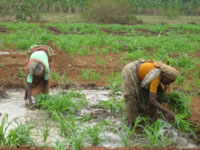 Women are involved in many activities especially in the tribal villages. They go to the forest along with men to gather NTFP, assist them in agriculture activities, attend to their livestock, work as unskilled labourers, run small businesses and take care of the family when men have to go out to work. In several households, men migrated to several south Indian towns in search of work to earn their living. There is chain migration to parts of Arunachal Pradesh (Souras settled there during the time of Maharaja of Gajapati on his tea estates in the state of Assam) as well. Very few women accompany them. Women were organized into SHGs in many villages, and they undertook various business activities to add to their incomes. Vehicles purchased by households or self-help groups are rented to make additional income. Women are involved in many activities especially in the tribal villages. They go to the forest along with men to gather NTFP, assist them in agriculture activities, attend to their livestock, work as unskilled labourers, run small businesses and take care of the family when men have to go out to work. In several households, men migrated to several south Indian towns in search of work to earn their living. There is chain migration to parts of Arunachal Pradesh (Souras settled there during the time of Maharaja of Gajapati on his tea estates in the state of Assam) as well. Very few women accompany them. Women were organized into SHGs in many villages, and they undertook various business activities to add to their incomes. Vehicles purchased by households or self-help groups are rented to make additional income.
Table 5. Women’s livelihood profile in Gumma.
| Activities |
Number |
Percent of total * |
Labourers |
3269 |
25.0 |
Agriculture (owned/leased) |
2376 |
17.0 |
Livestock |
2361 |
18.0 |
Collection of forest products |
2751 |
21.0 |
Post harvest activities |
2188 |
17.0 |
Other activities |
136 |
1.0 |
Total women involved in different occupations |
13081 |
|
* Note:
1. Women engage in multiple activities would get counted against each activity.
2. Percentage figures indicate the percentages to the total women engaged in different occupations and not the actual number of women or economically active women
Most of the women are engaged as agricultural labourers. Collection of forest products including NTFPs and engaging with livestock are second and third important activities. Women labourers and those engaged with livestock should be the major clients of future agricultural programmes.
Step 4. Details of women’s aspirations
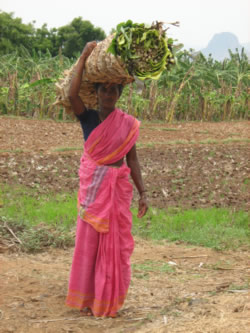 Women have multiple aspirations. The study revealed that all of them want to improve their standard of living and have a good quality of life. Those who could articulate their aspiration, talked about constructing a better house and providing better education to their children. Except for the few women who are constrained by caste, occupation and religious constraints, all of them want to improve their income by engaging in some of the activities/occupations, which they currently see as relevant. Women have multiple aspirations. The study revealed that all of them want to improve their standard of living and have a good quality of life. Those who could articulate their aspiration, talked about constructing a better house and providing better education to their children. Except for the few women who are constrained by caste, occupation and religious constraints, all of them want to improve their income by engaging in some of the activities/occupations, which they currently see as relevant.
Table 6. Aspirations identified by women to increase income.
| Aspirations identified by women |
Gumma block |
Agriculture/Horticulture Owned/Leased land |
3.35 |
Aquaculture |
- |
Business Non farm activity |
28.63 |
Employment |
0.74 |
Fisheries |
- |
Labour Agriculture |
- |
Labour Non-Agriculture Skilled |
0.37 |
Livestock |
1.49 |
None |
7.43 |
NREGS |
- |
Others |
76.58 |
Post harvest activity |
0.37 |
Rent on Assets |
|
- Business non-farm includes grocery shops, small petty shops, cashew and NTFP business, tiffin centres, tea shops, goat business, tailoring shops, cloth shops, small contractors etc.
- Livestock includes dairy, piggery, poultry and goatery
- Labour Non-agriculture skilled includes artisanal, traditional and minor skills are barbers, carpenters, palm leaf weaving, drivers, mechanics etc
- Agriculture/horticulture owned/leased activity includes purchase of additional lands, improvement of the existing practices, fencing, irrigation facilities etc
- Aquaculture is promoting fish, prawn and shrimp culture either in own/leased lands
- Employment refers those who aspire to be employed in public and private sectors
- Fisheries in owned/shared crafts refer going for fish catching in owned /shared crafts
- Labour in agriculture implies assured labour availability throughout the year within the village especially in Mawphlang Block of Meghalaya
- NREGS refers to the rural employment guarantee programme implemented by the Government
- Others include education, better housing, pension, health services, toilets etc
- Post-harvest activity includes value addition to the farm/fish/forest produce
- Rent on Assets include lending out vehicles on hire, rent on building
Though many women in all the locations are keen on starting some non-farm business activity, none of them was able to suggest the kind of support and services they require for doing the same, except credit. All believed that if they could get credit, they could engage successfully in these activities. This clearly reveals their lack of experience of setting up new activities and also the lack of awareness and knowledge about other kinds of services and support (technical training, entrepreneurial skills, market links etc).
Step 5. Details of support and service networks
The final step of stage 1 was to collate information and details of the support and service networks available in Gumma block.
Table 7. Support and Service Network in Gumma block.
| Support and services |
Gumma block |
Electricity |
Except interior villages, rest of the block is electrified |
Communication |
Mobile phone are common, but connectivity not very good; limited access to internet, currently available only at the block |
Transport |
Well connected by road except for interior panchayats/villages |
Credit |
Several sources of credit-local money lenders, nationalized banks, private finance companies, micro-finance agencies, SHGs, church mandlis, |
Marketing |
A large network of traders and commission agents engaged in marketing cashew, fruits and NTFPs.
More number of people from the area are currently becoming traders.
Access to nearby markets in Andhra Pradesh |
Capacity Building |
Several NGOs actively working in the area on different issues; High level of awareness in people due to migration to big cities; People need more technical know-how to fully utilize this increased awareness; Language and literacy are major constraints for women |
Table 8 gives locations of individuals and organisations and their skills and roles performed in Gumma block of Gajapati district, Orissa:
Table 8. Location of Individuals and Organisations in Gumma block.
|
Individual/Organisation |
Contact Details |
I |
Local Government Departments |
|
1. |
Department of Agriculture |
|
2. |
Department of Animal Husbandry |
Near Telephone Exchange,
Paralekhamundi-761200,
Gajapati, Orissa |
3. |
Department of Forestry |
|
II |
Research and training organisations-(Government) |
|
1. |
Krishi Vigyan Kendra |
The Professor and Head, Krishi Vigyan Kendra,
R.Udayagiri, Gajapati, Orissa |
III |
NGOs |
|
1. |
Centre for Community Development (CCD) |
Contact Person : Mr. A.Jagannadha Raju, Secretary
Address : Near Check Post, Sridhar Nagar,
Pathapatnam Road,
Parlakhemundi – 761 200,
Dist. Gajapati, Orissa.
Phone : 06815 – 222516, Cell : 93384 16535
Email : ccdevraju@rediffmail.com Website : www.ccdindia.org |
2. |
SURAKSHA |
Contact Person : Mr. M.Motilal Reddy, Secretary
Address : Near Check Post, Sridhar Nagar-II,
Pathapatnam Road,
Parlakhemundi – 761 200,
Dist. Gajapati, Orissa.
Phone : 06815 – 224723, Cell : 94377 23687
Email : suraksha_gajapati@rediffmail.com |
3. |
Social Education and Reconstruction of Village Environment (SERVE) |
Contact Person : Ms. Sujata Sahu, Chair Person
Address : Sanmukha Rao Lane,
Parlakhemundi – 761 200,
Dist. Gajapati, Orissa.
Cell : 93377 15777
Email : serve_gajapati@yahoo.com |
4. |
Adivasi Development Society (ADS) |
Contact Person : Mr. Aranchu Sabar, Executive Secretary
Address : Kuttam,
Gumma, Dist. Gajapati,
Orissa.
Phone : 06815 – 282671
Email : dhanun68@gmail.com |
5. |
Program for Rural Awareness and Very Action (PRAVA) |
Contact Person : Mr. A.Appa Rao, Secretary
Address : Komati Street,
Parlakhemundi – 761 200,
Dist. Gajapati, Orissa.
Phone : 06815 – 222638
Email : apparao_63@yahoo.com |
6. |
Centre for the Upliftment of Rural Environment (CURE) |
Contact Person : Mr. G.Damodar, President
Address : Om Shanti Colony,
Parlakhemundi – 761 200,
Dist. Gajapati, Orissa.
Phone : 06815 – 223472
Email : cure_pkd@sify.com |
7. |
Gram Vikas |
Contact Person : Mr. Kailash Ch. Sahu, Programme Coordinator
Address : Friends Colony, Near Check Post,
Pathapatnam Road,
Parlakhemundi – 761 200,
Dist. Gajapati, Orissa.
Phone : 06815 – 222659
Email : gramvikas@gmail.com
Website : www.gramvikas.org |
8. |
World Vision |
Address : Near New Bus Stand,
Parlakhemundi – 761 200,
Dist. Gajapati, Orissa.
Phone : 06815 – 224392
Email : web_wvi@imart1947.com
Website : www.worldvision.org |
IV |
Financial institutions |
|
1 |
Gajapati Women Self Help Cooperative (CCD) |
Infront of State Bank of India, Gumma |
2 |
State Bank of India |
Near PHC Gumma, Gumma, Gajapati Dt |
3 |
State Bank of India |
Serango Village, Gumma block. Gajapati |
4 |
State Bank of India |
At College Junction, Paralekhmundi, Gajapati |
5 |
Berhampur Cooperative Bank |
Palace Street, Paralekhamundi, Gajapati |
6 |
Cooperative Urban Bank |
Gujarati Peta, Paralekhamundi |
7 |
Rushikulya Gramya Bank |
Palace Street, Paralekhamundi |
8 |
Andhra Bank |
Palace Street, Paralekhamundi |
9 |
Indian Bank |
Palace Street, Paralekhamundi |
10 |
Bank of Baroda |
College Road, Paralehka mundi |
11 |
Union Bank of India |
Old Bus Stand, Paralekhamundi |
12 |
Asmita Micro finance |
Anka Street, Paralekhamundi |
13 |
Biswa |
New Bus Stand, Paralekhamundi |
14. |
Golden Land Developers |
Paralekhamundi |
V |
Traders/commission agents |
|
1. |
Agriculture: Khageswar Limma, Andersing for cashew and rice |
Gumma, Gajapati |
. |
Naresh Chinchani, Andersing, for All Goods and Rice |
Gumma, Gajapati |
2. |
Forest Produce |
|
|
Eliyazar Gamango, for cashew and all goods |
Ambajhari,Gumma |
|
Jisaya Paricha, Ambajhari for cashew, tamarind, tenna and termiri |
Ambajhari,Gumma |
|
Nabad Limma for cashew, tamarind and all goods |
K.C.Pur, Gumma |
|
Manoniti Pall for cashew and tentili and many others |
Gumma, Gajapati |
VI |
Others-Livestock |
|
|
Chitrasen Chinchani for livestock |
Anderrsingh, Gumma |
|
Captain Pani for Cow |
Gumma, Gajapati |
|
Jihijikal for Hen |
Gumma, Gajapati |
|
Abraham Pani for cows and buffaloes and many others |
Ashrayagada |
|
Table 9. Distance to key facilities in Gumma from select villages.
| S.No |
Details |
Figures in km |
1 |
Average distance of Bus stop |
3.84 |
2 |
Average distance of Telephone availability |
3.27 |
3 |
Average distance of Government Doctor available |
10.38 |
4 |
Average distance of Private Doctor available |
12.04 |
5 |
Average distance of Bank available |
9.91 |
6 |
Average distance of Post office available |
4.04 |
7 |
Average distance of Primary school availability |
0.69 |
8 |
Average distance of Secondary School availability |
6.16 |
9 |
Average distance of the College |
28.29 |
10 |
Average distance of Internet facility available |
29.42 |
11 |
Average distance of district Head Quarters |
29.80 |
12 |
Average distance of Block Head Quarters |
17.87 |
|
Step 6. Implications for Programme Design
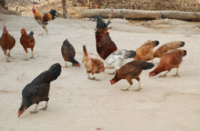 On completion of the baseline data, the project team reviewed the information and identified some important points that need to be borne in mind when moving onto the design stages. The implications for programme design in Gumma are as follows: On completion of the baseline data, the project team reviewed the information and identified some important points that need to be borne in mind when moving onto the design stages. The implications for programme design in Gumma are as follows:
- Interventions to raise production and productivity in land-based activities (crop production, livestock, poultry and fisheries) can generate adequate incomes only if issues related to irrigation, financing, marketing, value addition and pricing are also simultaneously addressed.
- Agricultural labour households do not have round the year employment and so enhancing their capability to use their labour productively in the lean seasons can improve their incomes.
Majority of the rural women comprises women labourers and those involved in small livestock. Both these groups should be the primary target for programmes for rural women.
- In Gumma, land based activities are not considered important by the women.
- Non-farm activities, especially doing some business, are considered by the communities as a good option for improving current incomes in Gumma.
- Most of the women-specific programmes, assume that more programs should be initiated for women in agriculture, considering their multiple involvement in agriculture. However, the communities do not consider farming as the best option to improve their incomes.
- Programmes for rural women therefore should be willing to explore the scope and feasibility of other alternative livelihood options, which the women consider important.
|
